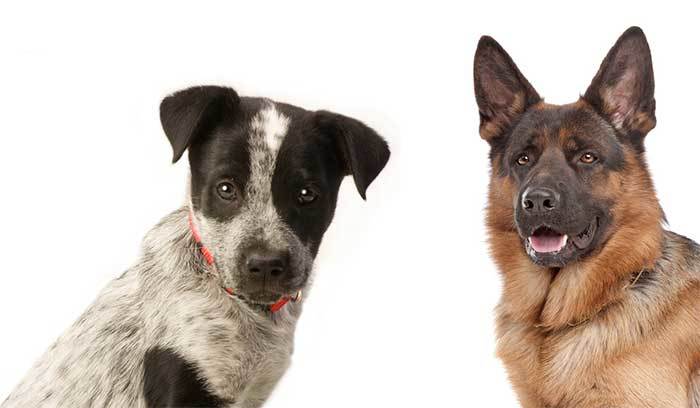The Blue Heeler German Shepherd Mix is a delightful and unique mixed breed dog.
His pictures alone are enough to make your heart melt!
Unfortunately, not many people know that this dog actually exists.
Here, we’ll take a look at the physical characteristics, personality traits, training and health issues of this crossbreed as well as some detailed information about the origins of both parent breeds.
So stay tuned!
By the end of this article, you should be in a position to decide if this crossbreed is a good fit for you and your family.
Table of Contents
What is a Blue Heeler German Shepherd Mix?
This is a designer dog that is developed by crossing the Blue Heeler (also known as the Australian Cattle Dog) with a German Shepherd (often abbreviated as GSD).
Ideally, this cross combines the enthusiasm of the Blue Heeler with the kindly, easy-going disposition of the German Shepherd.
This makes the Blue Heeler German Shepherd Mix a powerful working dog that is clever, determined and loyal.
However, it is important to point out here that the resulting puppies can inherit the physical characteristics and the personality traits of either parent breed.
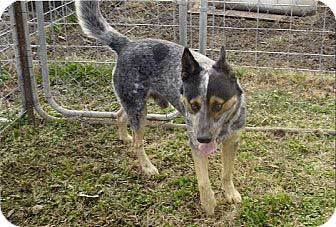 Blue Heeler and German Shepherd Mix – Source
Blue Heeler and German Shepherd Mix – Source
The hybrid might also look like a perfect blend of both parent breeds or lean towards one breed over the other.
Since both the Blue Heeler and the German Shepherd are members of the AKC’s herding group, their offspring should also be a good herder.
This mix is also known as the German Shepherd Australian Cattle Dog Mix.
But where did the German Shepherd Heeler Mix come from? What’s his origin?
Well, he is a relatively new crossbreed in the canine world. That’s why his historical background seems to be mysterious.
However, it is widely believed that the Blue Heeler Mix with German Shepherd was created in the last 30 or so years.
Now that you’ve got a grasp of the basics, let’s take a closer look at the parent breeds.
The Blue Heeler aka Australian Cattle Dog (ACD)
As a breed, the Blue Heeler originated in the harsh climatic conditions of the Australian Outback and was commonly used as an aid in livestock herding.
A wide variety of breeds were used in the early stages of developing the Australian Cattle Dog. That said, as you’ll notice, this dog is a crossbreed in itself.
ALSO: The Truth About The Blue Heeler Husky Mix and Ausky Dog
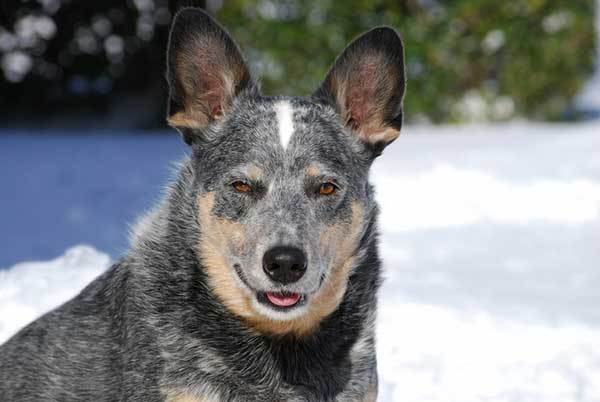
The early stock that was used in developing the breed included:
Smithfield: a sturdy herding dog that originated in the British Isles.
Dingo: these Australian wild dogs were used to boost endurance.
Blue Smooth Coated Highland Collies: these dogs were added in the 1840s by NSW cattle farmer Thomas Simpson Hall to modify the otherwise loud and aggressive Heelers.
Bull Terrier: these dogs were used in the 1870s to enhance stockiness.
Dalmatian: the Dalmatian was added to increase the love of cattle and loyalty to their owners.
Kelpie: the Australian Kelpie was added to instill a good work ethic and the tan markings characteristic of Blue Heelers today.
The Australian Cattle Dog is extremely intelligent and can solve problems on the move. He can also be stubborn because of the tenacity necessary to herd challenging cattle.
They also tend to be possessive and some can be aggressive towards other dogs. Therefore, proper socialization is a must for your Blue Heeler Mix dog.
SUGGESTED ARTICLE: Everything You Need to Know About Blue Heeler training
The German Shepherd (GSD)
The German Shepherd is one of the most popular dogs in the United States today. This dog is also intelligent and loyal.
The history of the German Shepherd begins in the late 1800s when Captain Max von Stephanitz decided to develop the ultimate German herd dog. In fact, the present-day German Shepherds are descendants of his herd dog, Horand von Grafrath.
Stephanitz also played a huge role in defining the early standards for the breed. Among his priorities were working potential and high intelligence levels.
As livestock farming methods improved, their herding use reduced drastically. Nonetheless, their intelligence and spirited nature remained the same.
Today, German Shepherds are commonly used for military and police activities around the world.
SUGGESTED ARTICLE: The Great Dane German Shepherd Mix (Ultimate Guide)
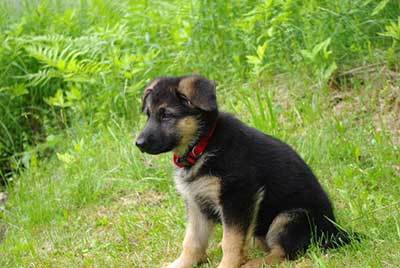
But did you know?
The German Shepherd dog is sometimes also known as an Alsatian.
All variations of the German Shepherd – including the White German Shepherd and the Black German Shepherd – are extremely intelligent.
As with all dogs, the amount of care and love you shower on your GSD will be returned to you and your family manifold.
Physical Characteristics of the Blue Heeler German Shepherd Mix
Descending from two different breeds, it can be difficult to predict the physical characteristics of each puppy.
A Blue Heeler German Shepherd Mix puppy can take on the traits of either parent or become a combination of both.
The upright ears of both parent breeds is a must. However, the coat color will be a combination of the “blue” shade of the Blue Heeler and the light brown coloring of the German Shepherd.
This cross also has a strong, muscular body, just like both parent breeds. Both parents are working dogs and their offspring will have a shorter frame and broad shoulders.
Size, Height and Weight
Blue Heelers are generally short and strong. Meanwhile, the German Shepherd is also a very powerful dog, although taller, leaner and longer.
As you would expect, it can be difficult to foretell the adult size of their offspring.
Expect a full grown Blue Heeler German Shepherd Mix to weigh anywhere between 35 and 90 pounds. He should reach around 18 to 26 inches tall.
Males are generally larger, but females will also have a strong, athletic body.
The Personality & Temperament of a Blue Heeler German Shepherd Mix
Another major concern among prospective dog owners is the temperament of a designer dog like the German Shepherd Cattle Dog Mix.
With any hybrid dog, it is important to keep in mind that crossbreeding does not guarantee the desired personality traits of a dog.
To understand his temperament, you need to study both the parent breeds.
Strength and bravery are both attributes that both the parent dogs share. They are both loyal and protective, making them good guard dogs.
Both parent breeds also share a good work ethic, intelligence, endurance, herding skills and a general tendency to be quite stubborn.
 German Shepherd Australian Cattle Dog Mix – Source
German Shepherd Australian Cattle Dog Mix – Source
When you cross the Australian Cattle Dog with the German Shepherd, you end up with an intelligent dog that is suited to work and play.
These strong and athletic dogs are likely to be destructive if left alone for an extended period of time.
With this mix, expect an alert and steadfast dog that will always be ready for anything. These pups can be possessive and tend to be wary of strangers.
Since both the parent dogs get along well with adults and older children, your Blue Heeler German Shepherd Mix could be a good family pet.
However, this mix can be somewhat unpredictable with young kids. This fact should be taken into consideration before buying or adopting one of these dogs as a family pet.
Training
If you think that a Blue Heeler German Shepherd Mix might be a good match for you, be sure that your new furry friend will be intelligent and quick-witted, just like his parents.
When you teach this dog various commands, he will learn quickly. But since these dogs tend to be quite stubborn, make sure to start training them early as puppies.
It is natural for both parent breeds to be dedicated and family-oriented. However, obedience training is important if you want to keep your pup out of trouble.
Without proper training and socialization, your Blue Heeler German Shepherd Mix puppy will not obey any commands. Their defence-based, protective personality may reach extreme levels.
During training, be sure to give your dog clear and simple commands. Using complex sentences or too many unnecessary words can lead to confusion and frustration on the part of the dog as well as the trainer.
Further Reading: A Guide To Some Of Best Dog Training Books Available Today (Top 24)
Do not use harsh words or punishment-based methods as this will make your dog aggressive. Otherwise, you can expect this cross to respond well to positive reinforcement training techniques.
Strong leadership is important if you want your dog to learn quickly. To make your dog obey any rules you set, be authoritative and firm with him.
Teaching him to stay, sit and come is very important. There are quite a few acceptable ways of housetraining a German Shepherd Cattle Dog Mix puppy. Crate training is recommended if you want to adapt your puppy to a safe and comfortable environment.
A properly trained and socialized Blue Heeler German Shepherd Mix puppy will end up being a hardworking, loyal and obedient canine friend.
But if you think you’re not up to the task, you should consider seeking the help of a professional dog trainer. Otherwise, you may want to check out other dog breeds, especially if you’re a first-time dog owner.
Exercise Requirements
The German Shepherd Australian Cattle Dog Mix is a high-energy dog who loves to stay active as well as play around throughout the day.
This cross is just as active as his parents, so be sure to provide him with the necessary physical exercises as well as the mental stimulation he needs to remain happy and healthy.
Ideally, you should be physically active yourself and have a proper daily exercise routine in place. This dog loves various physical activities.
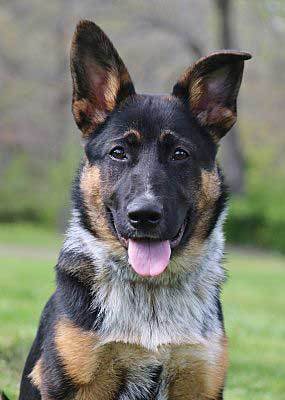
If you’re a cyclist or jogger, you’ll find a good companion in the Blue Heeler German Shepherd Mix because these dogs enjoy running along their owners.
Although taking your dog out for daily walks is highly recommended, he will also need to play and run around to release his limitless energy.
The least amount of exercise a Blue Heeler Mix with German Shepherd needs is two walks per day.
Playing together can also help strengthen the bond between you and your beloved dog. Games such as Frisbee or Tug of War are also an excellent way to tire out your dog.
Grooming
It doesn’t have to be difficult to take proper care of your German Shepherd Cattle Dog Mix. However, there are a few things you need to keep in mind.
These dogs have a double coat, but minimal grooming demands. Grooming your dog might be quite easy, but if he inherited the longer coat of his GSD parent, he will have moderate grooming needs.
This mix has a strong tendency towards heavy shedding whereby he loses his undercoat. During such periods, you should brush him each day to help keep his coat healthy. Since this dog’s skin can be sensitive, be sure to use a bristle brush.
Bathing should be done only if he gets particularly dirty. Bathing him too frequently could make his skin dry. A good option is to use quality deodorizing wipes for dogs to keep his skin properly conditioned at all times.
Additionally, brush your pup’s teeth several times each week and clean his ears at least once per week. His nails also need to be clipped to prevent them from getting too long.
Further Reading: What Is The Best Brush For Shedding Dogs? (Top 15)
Feeding Info
These dogs require 2 to 3 cups of high quality dog food each day. They also need to be fed two to three times each day to remain happy and healthy.
You can also provide vitamins and fish oil to supplement his diet.
Recommended: Discover The Deadly Secret The Dog Food Industry Is Spending Millions To Make Sure You Never Find Out
Blue Heeler German Shepherd Mix Health Problems
The Blue Heeler German Shepherd Mix has a lifespan of 11 to 14 years.
This mixed breed dog is considered to be quite healthy. However, chances are he can inherit the health issues of his parents.
Not all puppies will suffer from all those conditions, but it is important to know them if you’re considering adding this dog to your family.
They include hip and elbow dysplasia, epilepsy, eczema, deafness and eye disorders.
You can ensure your puppy has greater odds at good health by buying from a reputable breeder and also using the Embark Dog DNA Test Kit to find out about his heritage and any potential health concerns.
Finding Healthy Blue Heeler German Shepherd Mix for Sale/Adoption
When purchasing any dog, it is important to find a reputable breeder.
A good breeder will be happy to meet you in person and find out if this dog is a good match for you. They will also allow you to meet both parent dogs.
Make sure to check the health of both the litter and the parent dogs before making your purchase.
You can also go online, search for reputable breeders, view pictures and check the price of any Blue Heeler German Shepherd Mix puppies that are available for sale.
Alternatively, you can visit local animal shelters and rescue organizations and see whether they have any of these puppies or dogs available for adoption.
Conclusion
A Blue Heeler German Shepherd Mix is a wonderful dog to own. Imagine the enthusiastic Blue Heeler and the industrious, easygoing German Shepherd dog rolled into one!
If you lead an active lifestyle and need a loyal and intelligent companion, this dog is a good fit for you.
Just make sure to buy your puppy from a responsible breeder who will help ensure your Blue Heeler German Shepherd Mix is healthy and will live for many years to come.

